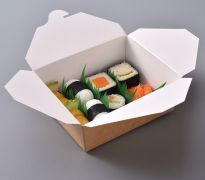Food Paper
Food paper is made from materials that are safe for direct contact with food. Common materials used include wax-coated paper, grease-resistant paper, parchment paper, and food-grade plastics like polyethylene or polypropylene.
- Available 50-300 gsm
- Size 70x100, roll
Available GSM: 250, 300
Size: 70x100
It is suitable for all popular printing techniques from high-speed offset printing to silk screening, embossing, hot foil stamping, die-cutting etc.
Food wrapping paper, also known as food-grade paper or food packaging paper, is specifically designed and manufactured for wrapping or packaging food items. It is used to protect and preserve the freshness, quality, and hygiene of various food products. Here are some key features and considerations related to food wrapping paper:
-
Food-Grade Material: Food wrapping paper is made from materials that are safe for direct contact with food. Common materials used include wax-coated paper, grease-resistant paper, parchment paper, and food-grade plastics like polyethylene or polypropylene.
-
Grease and Moisture Resistance: Food wrapping paper is often treated or coated to resist grease and moisture. This helps prevent oil, liquids, or condensation from seeping through the paper, maintaining the integrity of the packaging and preventing food contamination.
-
Breathability: Some food wrapping papers are designed to allow air circulation, which helps in maintaining the freshness of certain food products. For example, bakery paper or deli paper allows for some moisture release, preventing the accumulation of excess moisture that could affect the texture of baked goods or deli items.
-
Barrier Properties: Food wrapping paper may have barrier properties to protect the food from external factors such as odors, light, and air. Barrier coatings or laminations can provide additional protection and prolong the shelf life of the food.
-
Heat Resistance: Food wrapping paper is often heat-resistant to withstand the heat generated by hot food items or to be used in oven-safe applications like baking or reheating. Some types of food wrapping paper, such as parchment paper, can handle high temperatures without releasing harmful chemicals.
-
Food Safety and Regulations: Food wrapping paper is subject to various food safety regulations and certifications to ensure it meets specific standards for direct food contact. Look for papers that comply with FDA (Food and Drug Administration) regulations or other relevant food safety certifications in your region.
-
Types of Food Wrapping Paper: Food wrapping paper comes in various forms, including rolls, sheets, and pre-cut sizes. It can be used for different food applications such as wrapping sandwiches, burgers, baked goods, fruits, vegetables, or for lining food containers or trays.
-
Eco-Friendly Options: Consider using eco-friendly food wrapping paper made from recycled materials or from renewable resources like unbleached paper or compostable materials. These options are more environmentally friendly and align with sustainable practices.
When using food wrapping paper, it's essential to follow proper food handling and storage guidelines to maintain food safety. Ensure that the wrapping paper is suitable for the specific food item and that it meets the necessary regulations for direct food contact.





